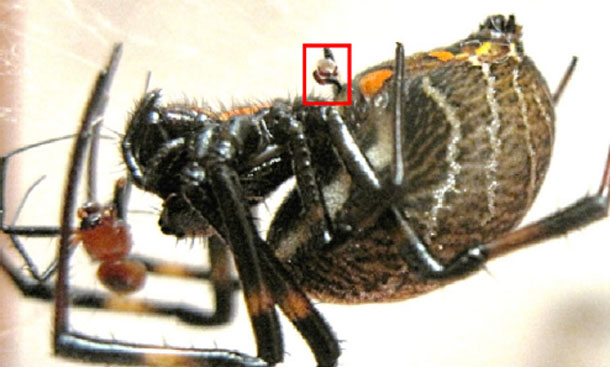We're open daily! View holiday hours
Science News
Spider Mating
February 6, 2012

Survival of the fittest, right? Here’s a fantastic story along those lines: Male spider breaks off genitals in female to flee quickly and avoid being eaten after mating. What’s more, genitals continue to produce sperm to spread the male spider’s genes long after he’s left the scene.
Or so goes a new study in published in Biology Letters last week. According to that abstract:
We conclude that the mechanism [genital break-off] may have evolved in response to sexual cannibalism and female-controlled short copulation duration.
Dang! You have to respect evolution!
And that’s the theme of a new exhibit opening at the Academy later this week: Animal Attraction—“sex drives evolution; nothing in life is more important.” The exhibit includes animals, specimens, images, videos and the weird and wild stories behind animal reproduction. In one species, the coral banded shrimp, the deviant mating behavior is monogamy. Well, sociopathic monogamy. We’ve produced a Science in Action video to supplement the exhibit explaining the mating habits of nearby elephant seals and banana slugs—very different mating strategies, but equally dangerous.
Which brings us back to these Nephilengys malabarensis spiders. As Ed Yong reports in Nature News:
Male spiders deliver their sperm through a pair of structures known as palps, which are found on the sides of their heads. By observing sexual encounters between 25 pairs of virgin N. malabarensis, [lead author Daiqin] Li's group found that every coupling ended with damage to the male’s palp. In 12% of cases it was partially severed; in the rest it snapped off completely.
Yikes! But not only does the palp continue to deliver sperm to the female spider, it also blocks the entrance should she encounter another male spider. And, as we reported a couple of weeks ago, even as a eunuch, the male spider is still tough, actually becoming better fighters “without their heavy palps,” says Yong.
Passing along their genes long after mating, becoming better fighters and, perhaps most importantly, staying alive—these spiders are highly evolved to survive. Well done!
Image: Joelyn Oh